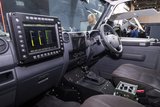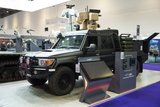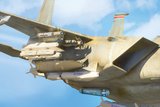Deploying artificial intelligence at the tactical edge for next-gen combat vehicles
Brought to you in partnership with Systel
Advances in computer processing and networking technologies in the past decade have resulted in a flood of information now being presented to the crews of armoured vehicles.
The ability to seamlessly collect, exploit and disseminate sensor data, targeting and navigation information, and audio/video feeds has helped to change the face of warfare but can easily overwhelm the military user.
Leveraging advanced computing technologies in conjunction with recent developments in artificial intelligence (AI), specifically deep learning (DL) and machine learning (ML), promises to solve mission-critical data processing workloads of the armoured vehicle crew.
Today’s multipurpose embedded mission computers employ powerful graphics processing units (GPUs) allowing the use of AI to shift the workloads from man to machine and optimize and enable critical capabilities such as aided target recognition and detection (AiTR/AiTD), shot detection, autonomous mobility, active protection systems (APS), threat detection and identification, and predictive analytics and maintenance.
‘Next-generation platforms create enormous amounts of data which can result in information overload challenges for the warfighter,’ explains Aneesh Kothari, vice-president of marketing for Systel, Inc, which has inserted itself squarely in this segment of the market.
View full-size image.
‘The key is to incorporate the optimal electronics architecture to support the explosion of new functionalities that is taking place through the US Army’s next-gen modernization priorities. We’re able to bring high performance embedded edge computing [HPEEC] solutions to market which take data centre processing capability and bring it to the forward edge in a contested environment.’
Today’s GPUs are designed for massive parallel processing and exponentially dwarf the calculation rates of even the most powerful CPUs, creating the ability to carry out data intensive analytics on sensor data in milliseconds opposed to seconds, minutes or hours.
With the introduction of modern AI, the aim is not to take the human out of the loop but to use autonomous capabilities to scan, detect and assess threats in timeframes measured in milliseconds and present the relevant threat data to the armoured vehicle crews.
‘The concept of manned-unmanned teaming is to reduce the cognitive load on the operator. Modern vehicles are generating an enormous amount of raw data – potentially petabytes of data in real-time speeds,’ Kothari says.
‘How do you seamlessly team man and machine to reduce demand on the vehicle crew and operators, streamline decision making inflection points, and ultimately better protect your assets and maintain tactical advantage? How do you capitalize on human in the loop feedback to autonomous decision engines to improve performance and efficiency of your man-machine teams?’
For applications such as hostile fire or IED detection, protection is provided by these intelligent computing applications, which utilise AI and DL techniques to analyse the feeds from a variety of sensors continuously scanning the environment and producing data around the armoured vehicle much faster than a human operator can process information.
‘AI technologies such as lens tracking and gesture recognition can be harnessed within your edge computing engines by interrogating video and presenting potential threat matrices to the vehicle crew. Another great example is facial recognition. Biometric analysis can be conducted in the background by using sensor data that is already being collected. The data is there, it’s just a question of using it.’
While much of this AI functionality is software based, any solution must be based on high-performance embedded mission computers able to handle the processing requirements, sensor-fusion capabilities and CPU/GPU integration.
Above: A UH-1 Huey equipped with the Office of Naval Research-sponsored Autonomous Aerial Cargo/Utility System (AACUS) autonomy kit departs the landing zone following a resupply mission requested using a handheld tablet at Marine Corps Base Quantico during a 2017 demonstration. (US Navy)
Systel has developed its Strike™ series of embedded computers to meet these requirements in a SWaP-, cooling- and cost-optimised single LRU.
The company has also gained the experience of being involved in several AI developments, including the Autonomous Aerial Cargo/Utility System (AACUS) with Aurora Flight Sciences/Boeing and the Pentagon’s Project Maven initiative.
A planning and mission system software package combined with sensor suite, AACUS is designed to autonomously operate a full-scale rotary wing aircraft into and out of austere landing zones.
AACUS enabled cargo unmanned systems are able to plan missions and execute them with minimal human involvement, with the AI determining safe landing areas, landing the aircraft autonomously avoiding obstacles.
Above: Raven-Strike™ offers complete sensor integration and data fusion, in a SWaP-optimised system.
View full-size image.
Kothari explains that beyond the above examples, the use of AI would likely gain traction across many military modernisation programmes as new embedded computers were introduced and the AI technology was proven.
‘It’s easy for AI to become this big black box with an artificial bubble of expectations built around it. We aren’t part of this hype cycle. We view the AI edge ecosystem as made up of fundamental pillars including the engines that run on neural networks and the sensors that generate and provide the raw data needed to feed your deep learning algorithms within a given ecosystem.
‘All of these tools are based on one thing – the edge computing hardware backbone that hosts all of this immense capability. Our sophistication in this space allows us to design and manufacture purpose-built systems that exactly meet the needs of the end user.
‘AI will be a strong component across the board in the US Army’s big six modernization priorities. Whether it’s robotic combat vehicles, manned-unmanned teaming, autonomous cyber defence to harden our tactical networks, AI along with the edge computing architecture needed for tactical deployment is critical.’
Systel will be presenting its rugged AI-enabling computing solutions in Booth #1200 at the 2019 AUSA ILW Global Force Symposium & Exposition March 26-28.
More from Studio
-
![Energy evolution: How laser defence systems are powering the next phase of air defence (podcast)]()
Energy evolution: How laser defence systems are powering the next phase of air defence (podcast)
Laser-based air defence is moving from promise to deployment as global threats evolve. In this special podcast, we explore how high-energy laser systems are reshaping interception strategies.
-
![Resilience, adaptiveness and collaboration vital for success in space (Studio)]()
Resilience, adaptiveness and collaboration vital for success in space (Studio)
Speakers at the Defence In Space Conference (DISC) 2025 highlighted the critical and evolving role of space in national security, defence and the global economy.
-
![Precision on Demand: The New Age of Loitering Weapons (Podcast)]()
Precision on Demand: The New Age of Loitering Weapons (Podcast)
Loitering munitions provide vital capabilities in the disrupted and unpredictable modern battlespace, from real-time ISR to a virtually “on demand” strike capability. Rafael is looking to the future of the technology, empowering systems to operate with increasing autonomy in hostile environments.
-
![Combat-proven capabilities: How precision-strike systems are evolving for tomorrow’s battlespace (podcast)]()
Combat-proven capabilities: How precision-strike systems are evolving for tomorrow’s battlespace (podcast)
Combat-tested technology is being reshaped to counter A2/AD threats, reduce reliance on GPS and enable faster, more autonomous targeting in complex environments. In this special podcast, experts explain how the evolving threat landscape is shaping next-generation strike capabilities.























